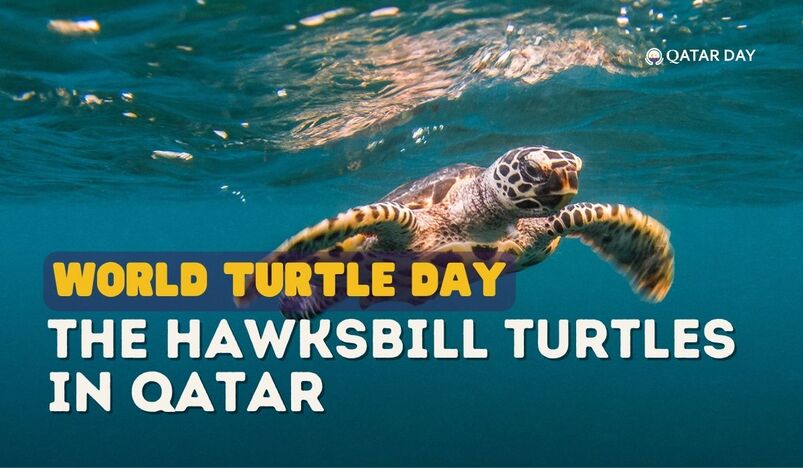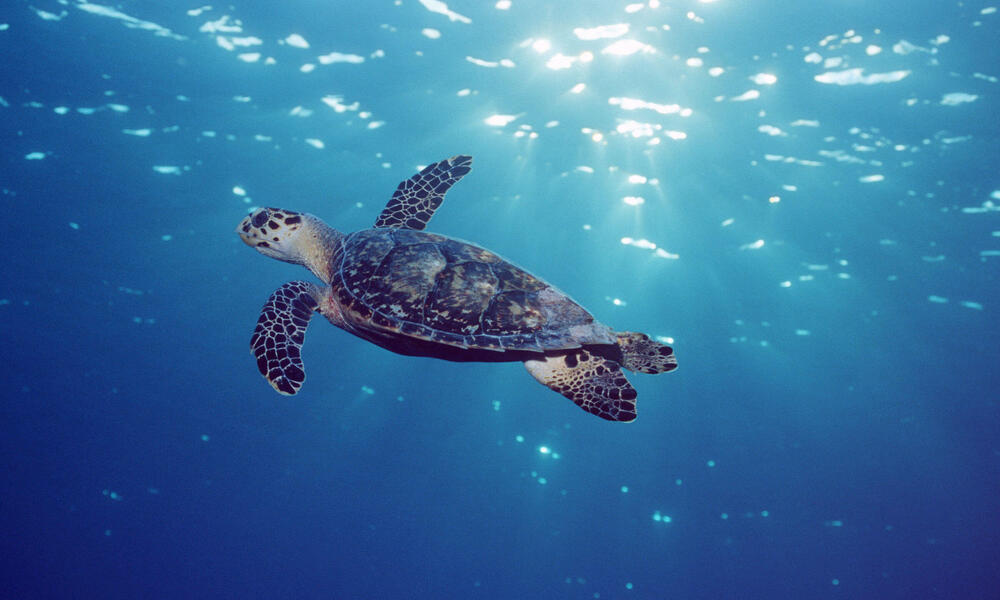
Qatar, a peninsula in the heart of the Persian Gulf, extends 160km from the Arabian Peninsula coastline. The Gulf features two currents flowing along its northern and southern shores, acting as migratory pathways for various species. These currents carry marine life from the Strait of Hormuz along the coasts of Iran, Iraq, Kuwait, Saudi Arabia, Bahrain, and Qatar, eventually reaching the waters of the United Arab Emirates. As the current flows into Qatar, it deposits sand along the northeast coast, creating ideal feeding and nesting areas for sea turtles.
Qatar is home to at least four species of sea turtles: the Green Turtle, Hawksbill Turtle, Olive Ridley Turtle, and Loggerhead Turtle. While Green Turtles are commonly seen at sea, it is the Hawksbill Turtles that nest on Qatar's beaches. The other turtle species are less frequently encountered, with Leatherback Turtles being particularly rare.
Hawksbill Turtle

Scientific Name: Eretmochelys imbricata
Class: Reptilia
Family: Cheloniidae
Facts about Hawksbill Turtles
Speed: 24 km/hr through water
Conservation Status: Critically endangered
Diet: Omnivore
Critically endangered Hawksbill turtles play a crucial role in maintaining healthy coral reefs and the marine ecosystem. They prefer tropical waters and are highly migratory, arriving in Qatar during early summer for nesting season. While Hawksbill turtles are found on various Qatari beaches, Fuwairit Beach’s soft sand and environment make it an ideal nesting site.
Every year, these amber-coloured turtles faithfully return to nest on Qatar’s shores, creating a captivating sight as hatchlings emerge. Hawksbill Turtles nest along roughly 50 km of the northeastern coast, from Umm Tais to Ras Laffan, and on the sandy beaches of the eastern offshore islands. Fuwairit Beach has become particularly popular over the past decade due to its significance as a habitat for three different species of sea turtles, especially the Hawksbill Turtle. These turtles are drawn to the region's rich marine resources, making it a preferred breeding ground.
Sea turtles in Qatar face numerous threats, including egg and hatchling loss due to poaching and predation by foxes, cats, and birds. Coastal development, reclamation, and sand removal caused by climate change-induced coastal erosion also pose significant dangers. Additionally, entanglement in fishing gear, pollution from oil spills and plastic ingestion, thermal pollution from desalination plants, and hazards from marine traffic, such as fatal collisions and propeller strikes, further threaten their survival.
Qatar has prioritized wildlife conservation, especially through the Turtle Conservation Project, to protect sea turtles. This initiative involves studying and monitoring turtle movements, protecting nesting sites, and incubating eggs in warm sands. Hawksbill turtles typically lay around 60 to 200 eggs during the nesting season, carefully depositing them in dug holes before returning to the sea. When necessary, eggs are moved to safer nests and protected until they hatch.
Starting in April each year, the Qatar Ministry of Environment closes beaches to create a safe environment for female Hawksbill turtles to lay their eggs without disturbance. Fuwairit Beach, which accounts for nearly 30% of all sea turtle nests in the country, is fenced off and closed to the public.
The Qatar Ministry of Environment and Climate Change actively enhances the protection of marine resources, including sea turtles. These magnificent creatures are truly a wonder to behold.
.jpg)
Qatar Secures Place Among the World's Top 10 Wealthiest Nations
.jpg)
Hamad International Airport Witnesses Record Increase in Passenger Traffic

Saudi Arabia: Any visa holder can now perform Umrah

What are Qatar's Labour Laws on Annual Leave?
Leave a comment